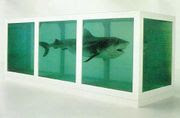Jehangir Jani, the Mumbai based artist was in town for the opening of his new exhibition ‘Metamorphoses’ comprising of fibreglass sculptures and drawings. I found his sculptures delightfully whimsical and suggestive of a trace of humour. The myriad heads are those of hybrid creatures – part human and part animal. The gold foil accentuates the animal characteristics against a featureless form of the black human head. Lionman, Elephantman, Rhinoman among other hybrid creatures surprise the viewer with their absurdity, craftsmanship and expressiveness. In these creatures of fantasy, the beastly quality presented against the stark and smooth metallic finish of the heads may even disturb the viewer. One feels that the animal traits in a human being are expressed with a sharp wit.
According to Jehangir, as we move towards being a more ‘civilised’ culture, we tend to suppress our animal instincts, but then it manifests itself in various other ways. He points out how the twentieth century was an era of discovery, knowledge acquisition and inventions, yet this phase was marked by wars and blood baths. Not to forget the growing number of troubled people turning to therapy.

I felt that the apparent contrast between the sophisticated appearance of the sculptures against the rawness of the drawings presents an interesting study. The drawings are in two sets, where the larger ones focus on internal strife and chaos, while the smaller works are darker and appear more intense, projecting the physical attributes of the brain itself in various adaptive stages in response to stimuli.
(The exhibition will be on till August 6 at Gallery Sumukha)
Digital Fix
On a completely different note, in this technological day and age you don’t expect anyone to be unfamiliar with either e-mails or use of computers. Well, there are artists who are far removed from technology, and rely completely on traditional methods of communication and painting. Then, there are artists who are so proficient with technical advances that they use it as a tool to create their art around it.
It is common to see artists taking digital photographs and modifying them with photo editing software - playing around with colours, backgrounds and other features (adding and deleting elements). And, some then print it on canvas and fill in the colours. There is a school of thought that believes that art should be completely done manually, and there are buyers reluctant to invest in such paintings (remember, here we’re not talking about digital art).
While, this is debatable, what the artist can do is to state clearly how the painting has been done and then leave it to the buyer to decide whether he wants to buy a digitally aided work or not.
(Published in Bangalore Mirror)














 For so many successful artists this can be such a vicious trap – they are forced to paint what the buyers want, but then critics pan them for repeating their works and not trying out anything new. A Catch 22 situation for them, don’t you think? Maybe sometimes we are too quick in judging artists; it helps to remember that at the end of the day this too is a profession for them. Artists also need to make ends meet and have families to support.
For so many successful artists this can be such a vicious trap – they are forced to paint what the buyers want, but then critics pan them for repeating their works and not trying out anything new. A Catch 22 situation for them, don’t you think? Maybe sometimes we are too quick in judging artists; it helps to remember that at the end of the day this too is a profession for them. Artists also need to make ends meet and have families to support.





 Abir Patwardhan's 'New Beginning'
Abir Patwardhan's 'New Beginning'


